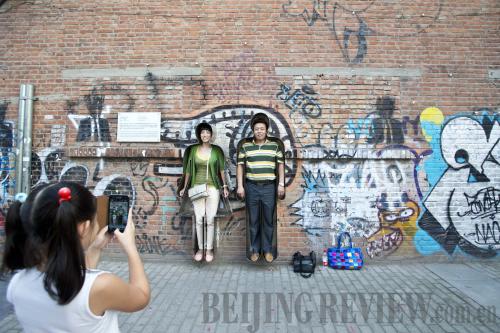|
 |
|
ART CENTER: A young girl photographs her parents during an exhibition at Beijing's 798 Art Zone, which was previously an electronics factory built in the 1950s (SHEN BOHAN) |
"Industrial heritage is an important part of the nation's cultural heritage. We must attach importance to industrial heritage and protect it in the same way as other historical relics," Shan noted.
Shan said that industrial heritage can be defined in a narrow sense as referring to industrial remains created after the Industrial Revolution, including sites, architectural structures, landscapes, machinery, documents and other objects, which have witnessed past or continuous industrial production processes, such as raw material processing and refining, commodity circulation, energy generation, transmitting and use, as well as transportation and all its infrastructure.
The Industrial Revolution started from the United Kingdom in the 18th century, and was mainly characterized by the use of such new-energy sources as coal and oil, as well as mechanical production.
In a broader sense, industrial heritage also includes processing, mining and handicraft sites used before the Industrial Revolution, including large pre-historical hydraulic projects and ancient sites for stone tool making and mining, according to Shan.
"Since the inception of the Industrial Revolution, production activities have greatly shaped urban landscapes. Due to industrial structure adjustment, some industries have gradually declined and their production sites have been abandoned. But they left behind a large amount of industrial heritage of historical and cultural value," said Yu Kongjian, Dean of the College of Architecture and Landscape Architecture at Peking University.
China's industrial revolution commenced in the latter half of the 19th century and has created various forms of industrial heritage.
Currently in China, not enough attention has been paid to industrial heritage conservation, said Zhang Tinghao, former President of the Chinese Academy of Cultural Heritage. "If no action is taken, a large quantity of industrial relics will vanish. When people realize how valuable they are, they will be filled with regret," he told national political advisors at a meeting during this year's full session of the National Committee of the Chinese People's Political Consultative Conference in March.
Zhang believes that for industrial workers and other urban residents, these plants and machines are more than bricks and steel, for they show how many generations of Chinese people have worked hard to realize their dreams.
"Although China's history of industrial development is only a little more than a century long, it has left us not only time-honored factory buildings, high furnaces, derricks and docks, but also the evidences of China's modernization process," Zhang said.
Gradual progress
On May 29, the Industrial Heritage Committee of the China Society of Cultural Relics was set up, marking a milestone in the preservation of China's industrial heritage. The committee, staffed by experts in cultural relic preservation, urban planning, architectural design and cultural development and exhibition, will explore effective ways to protect and use industrial heritage sites.
Shan, also President of the China Society of Cultural Relics, delivered a keynote speech at the committee's founding ceremony. He said that preserving industrial heritage is an important part of maintaining a city's history and its uniqueness.
"As part of human life, industrial heritage is of historical, social, scientific, technological and economic value," Shan noted, "It may have considerable aesthetic value for the quality of its architecture, design or planning."
In Shan's eyes, industrial heritage sites bear diversified characteristics because they were constructed for different purposes and in different styles. They represent technological progress as well as regional and historical settings in different time periods, and carry forward intangible cultural heritage such as artifacts and customs, he said.
|
